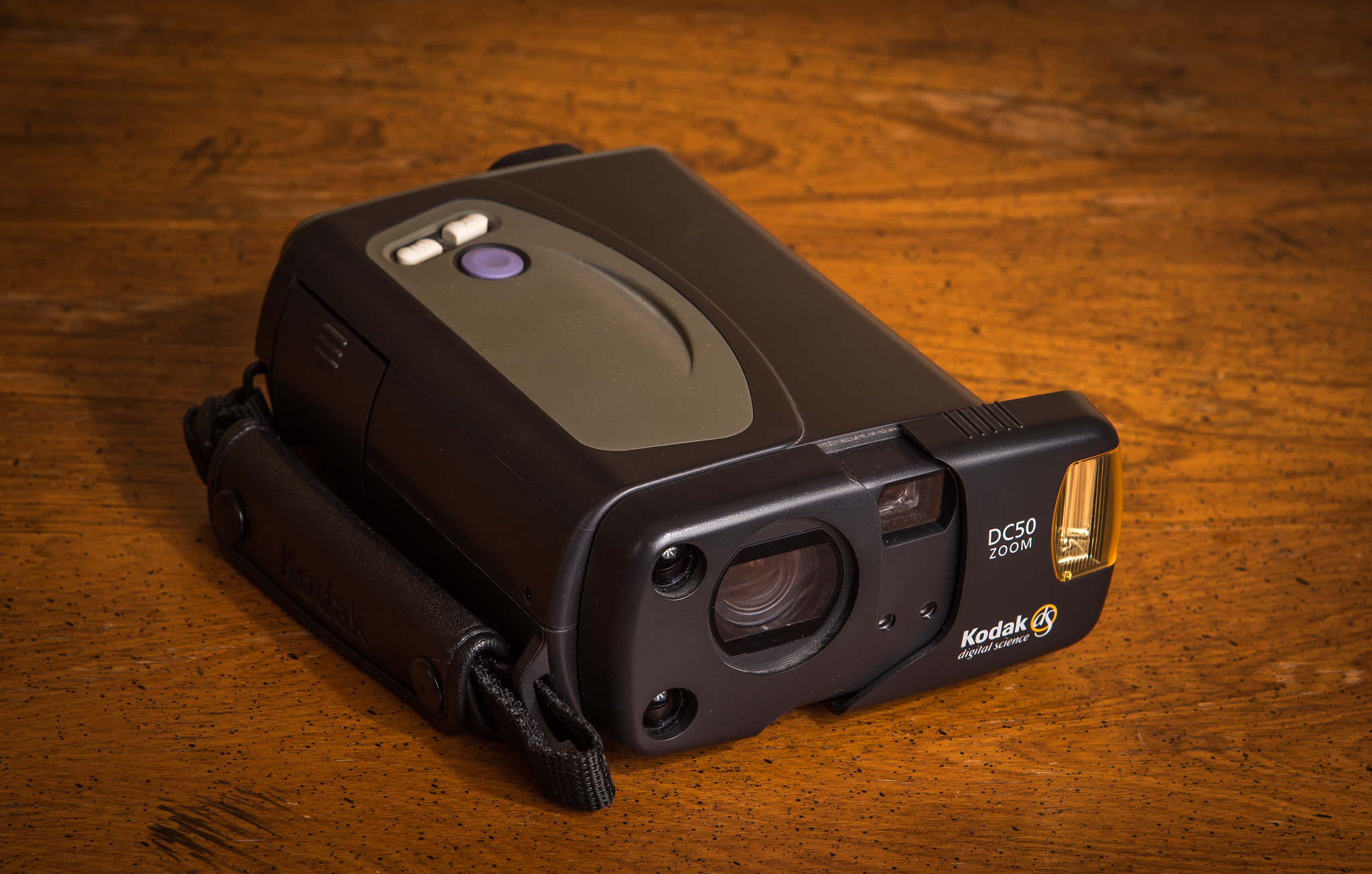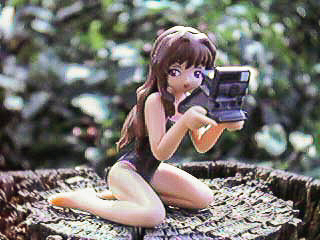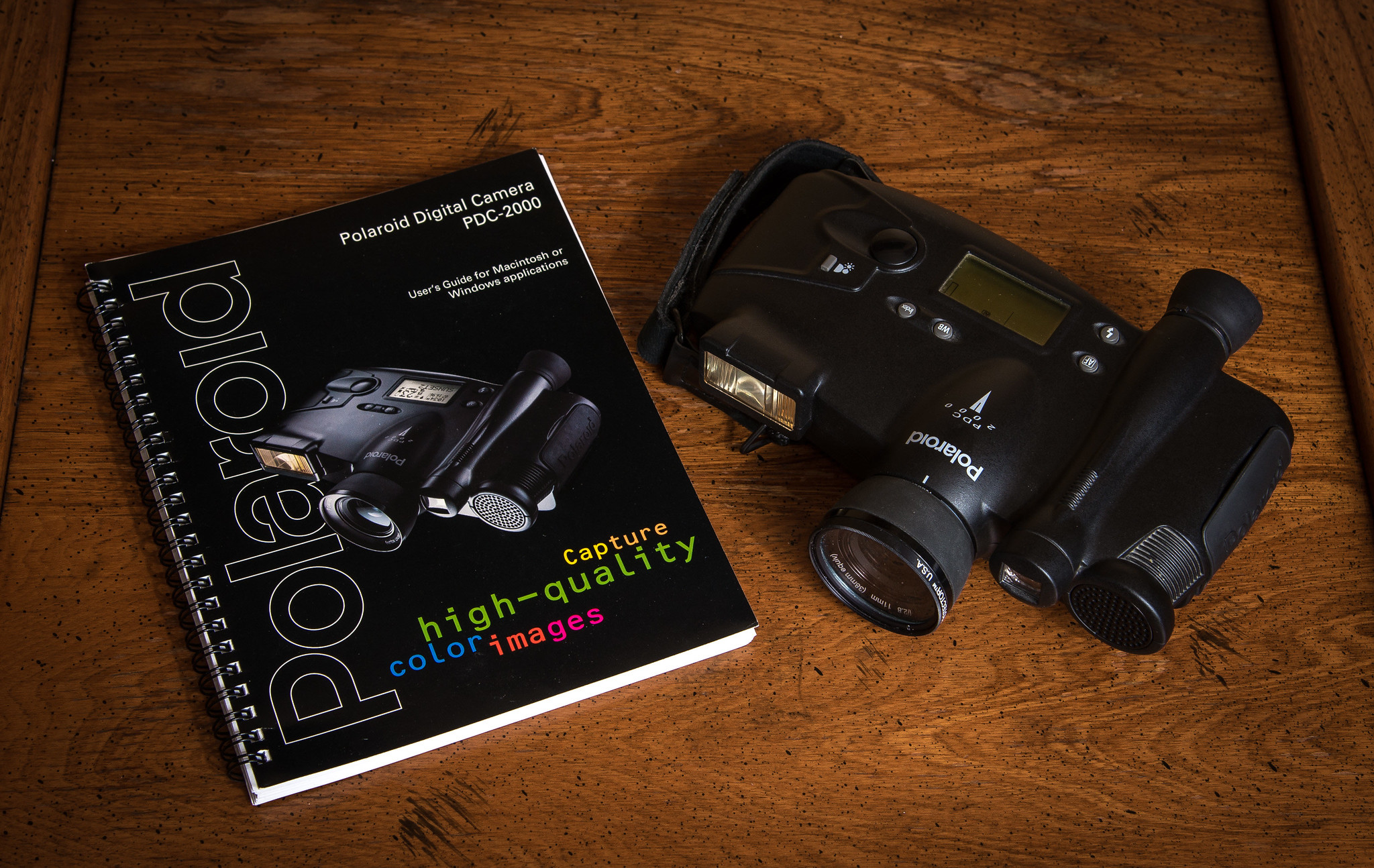You obviously have a good selection of vintage laptops also!
-
-
I have no choice if I want to use a multitude of vintage cameras 😄
-
My first digital "camera", at around the same time was the Aiptek PenCam, which probably doesn't meet many people's definition of a camera. It was small and light weight. And cheap. And took photos.
A review can be found here:
www.dansdata.com/vgapencam.htm -
Hi!
Yes, from the years 2000-2001, there was a real tide of cheap digital cameras without real interest.
At the beginning of 2001, there were already over 500 digital camera models available.And it was precisely during this period that the major brands of DSLRs such as Nikon and Canon appeared.
But that's another story, let's stick to digital compacts for now. -
1995
The Kodak DC40 Digital Camera (1995)
380,000-pixel sensor (756x504) with 4mb Internal
The First Compact digital Kodak
$995.00 USD
ISO 84
Kodak DC40 Digital Camera (1995) by Marc Aubry, sur FlickrAfter collaborating with Apple for their QuickTake, Kodak decides to release its own model.
The DC40 with a higher resolution (756x505) against (640x480) for the QuickTake.
Kodak DC40 Digital Camera (1995) by Marc Aubry, sur FlickrInteresting fact to note. In Canada the QuickTake 100 had been despised for sale in camera stores!
(a bit out of snobbery) The QuickTake was only found in computer stores. -
$2197 today. Crazy what we can get now. I remember looking at scanners and cams from Logitech around that time.
-
At $2197 USD, I'm ready to sell some of my cameras 😄 😄 😄

fotomans by Marc Aubry, sur Flickr -
Here the Kodak DC40 with the PowerBook G3 Series 233 mhz HD 2GB (1998)

Kodak DC40 Digital Camera (1995) by Marc Aubry, sur Flickr
Kodak DC40 Digital Camera (1995) by Marc Aubry, sur Flickr
Kodak DC40 Digital Camera (1995) by Marc Aubry, sur Flickr
Kodak DC40 Digital Camera (1995) by Marc Aubry, sur FlickrIt was not a very pleasant camera to use, in my opinion
-
Logitech
Sometimes it's hard to know who does what!?
At the same time, Logitech releases its FotoMan Pixtura.
A camera identical to the Kodak DC40, twin brothers.
Fotoman Pixtura (1995) by Marc Aubry, sur Flickr
Fotoman Pixtura (1995) by Marc Aubry, sur FlickrIn the end, nothing is very exciting with these two offspring.

Kodak DC40 (1995) / Fotoman Pixtura (1995) by Marc Aubry, sur Flickr -
Fotoman Pixtura (1995) and an HP nc8000 1.6 ghz (2004) with Windows 98

Fotoman Pixtura (1995) HP nc8000 1,6 ghz (2004) Windows 98 by Marc Aubry, sur FlickrFotoman Pixtura (1995)
390,000 pixels (768x512) with 4mb Internal
A carbon copy of the Kodak DC40
Fotoman Pixtura (1995) by Marc Aubry, sur Flickr
Fotoman Pixtura (1995) by Marc Aubry, sur FlickrIt does not make you regret your last purchase :)

Kodak DC40 / FotoMan Pixtura by Marc Aubry, sur Flickr -
1995-1996
The quintuplets 😎
In 1995-96, we see a multitude of cameras appearing with different names.
It becomes more and more difficult to know, who does what.They are also the first compact cameras with PCMCIA memory cards.

The quintuplets by Marc Aubry, sur FlickrChinon ES-3000 (1995)
Promaster Color Digital ONE (1995)
Dycam DC-10C (1995)
Dakota DCC-9500 (1995)
and finally the
Kodak DC50 Digital Camera (1996)The first four with 310,000 pixels (640x480) sensors
Only the Kodak DC50 stands out from the crowd with its 380,000 pixels (756x504)
Kodak DC50 Digital Camera (1996) by Marc Aubry, sur Flickr
Kodak DC50 Digital Camera (1996) by Marc Aubry, sur FlickrKodak DC50 Digital Camera (1996)
380,000-pixel sensor (756x504)
Storage: 1mb Internal & PCMCIA
$960 USDA collaboration between Chinon and Kodak, and Kodak eventually acquired Chinon.
-
The Casio QV-10 (1995)
The camera that gave acclaim to digital!
A camera that allows you to instantly see the results before and after shooting.
Faster and greener than Polaroid.This little camera heralds the beginning of the end for the empire of film photography.
Casio introduces the first digital camera with a liquid crystal display.
and a lens that rotates 180°
Casio QV-10 (1995) by Marc Aubry, sur Flickr
Casio QV-10 (1995) by Marc Aubry, sur FlickrCasio QV-10 (1995)
76,000-pixel sensor (320x240)
Storage: 2mb Int. (96 pictures)
5.2mm f/2 f/8 lens
$1,000.00 USD
ISO 800
Casio QV-10 (1995) by Marc Aubry, sur Flickr
Casio QV-10 (1995) by Marc Aubry, sur FlickrIts main drawback, is the tiny photos of only 320x240
A little too small, even for the time, 1995 -
For those who already have a computer at home, the Casio quickly becomes very exciting.
Unfortunately for us photographers, who have to pay around $1000 USD for a camera that only delivers microscopic 320x240 photos, that's something to think about!!
Casio QV-10 (1995)
LCD digital cameraHere the Casio QV-10 (1995) and QV10A (1996)
The QV-10A was a small update of the QV-10
Casio QV-10 (1995) & Casio QV-10A (1996) by Marc Aubry, sur Flickr
Casio QV-10 (1995) & Casio QV-10A (1996) by Marc Aubry, sur Flickr
Casio QV-10 (1995) & Casio QV-10A (1996) by Marc Aubry, sur Flickr
Casio QV-10 (1995) by Marc Aubry, sur Flickr -
No memory card for small Casio cameras.
We have to connect it to a computer to recover the 76,000-pixel photos
And each camera has its own software to establish the connection.
Casio QV-10 (1995) by Marc Aubry, sur Flickr
Casio QV-10 (1995) & HP compaq by Marc Aubry, sur Flickr
Casio QV-10 (1995) by Marc Aubry, sur Flickr
Casio QV-10 (1995) by Marc Aubry, sur Flickr -
It is now Ricoh's turn to want to impose itself in the digital world, with the…
Ricoh RDC-1 (1995)
410,000 pixels (768x480)
The First Digital Ricoh
$2,400.00 USD in 1995
8mb PC storage cards ($500)
Modular camera
Ricoh RDC-1 (1995) by Marc Aubry, sur Flickr*The Ricoh RDC-1 (1995) was the first digital camera capable of recording video

Ricoh RDC-1 (1995) by Marc Aubry, sur Flickr
Ricoh RDC-1 (1995) by Marc Aubry, sur FlickrThe logo on the memory card is premonitory
Ricoh devouring Pentax 😈 -
The Ricoh RDC-1 is a great camera, surely the most sophisticated in its category.

Ricoh RDC-1 (1995) Box by Marc Aubry, sur FlickrBut, why make it simple when you can make it complicated?
Very, very complicated… Very 😱
Ricoh RDC-1 (1995) box by Marc Aubry, sur FlickrNothing is standard on this camera: batteries, flash cards, connectors, etc… everything is out of the ordinary!

Ricoh RDC-1 (1995) by Marc Aubry, sur FlickrTo fully understand how the Ricoh RDC-1 works
Better to have a doctorate in infused sciences
And the manual must have been written by aliens!
Ricoh RDC-1 (1995) by Marc Aubry, sur FlickrI have never been so discouraged, before you can get this camera to work!

Ricoh RDC-1 (1995) ordi by Marc Aubry, sur Flickr
Ricoh RDC-1 (1995) by Marc Aubry, sur Flickr
Ricoh RDC-1 (1995/12) by Marc Aubry, sur Flickr -
EpixPro IC-100 (1996)
380,000-pixel sensor (640x480)
Storage: Two PCMCIA slots (PC Card ATA)
$1,950.00 USD
Marketed by NEC in Japan as NEC PC-DC401
EpixPro IC-100 (1996) by Marc Aubry, sur FlickrInterchangeable lens camera (C mount)
What makes this device so special is the fact that it incorporates a 486 processor
It's a mini-computer with a purpose
Another digital camera it's not easy to find today.
EpixPro IC-100 (1996) by Marc Aubry, sur Flickr
EpixPro IC-100 (1996) by Marc Aubry, sur Flickr
EpixPro IC-100 (1996) by Marc Aubry, sur Flickr -
Polaroid PDC 2000/40 (1996)
Darth Vader's Camera

Polaroid PDC 2000-40 (1996) by Marc Aubry, sur FlickrInterchangeable lens, and the focus made by sonar
Polaroid PDC 2000/40 (1996)
The First Digital Polaroid
960,000 pixels (1600 x 600 * int) with 40mb Internal
Photo of 800x600 or 1600x1200
$3,695.00 USD
Polaroid PDC 2000-40 (1996) by Marc Aubry, sur Flickr
Polaroid PDC 2000-40 (1996) by Marc Aubry, sur FlickrFor more information see here or here

Polaroid PDC 2000-40 (1996) by Marc Aubry, sur Flickr
Polaroid PDC 2000-40 (1996) by Marc Aubry, sur Flickr